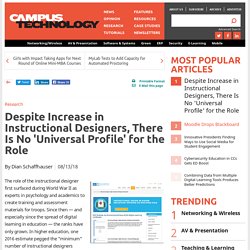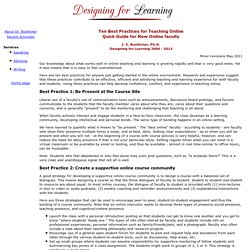

Despite Increase in Instructional Designers, There Is No 'Universal Profile' for the Role. Research Despite Increase in Instructional Designers, There Is No 'Universal Profile' for the Role By Dian Schaffhauser08/13/18 The role of the instructional designer first surfaced during World War II as experts in psychology and academics to create training and assessment materials for troops.

Since then — and especially since the spread of digital learning in education — the ranks have only grown. In higher education, one 2016 estimate pegged the "minimum" number of instructional designers employed by colleges and universities at some 13,000. "Instructional Design in Higher Education: Defining an Evolving Field" seeks to clear up the mystery. According to authors Elaine Beirne from Ireland's Dublin City University and Matthew Romanoski from the University of Arizona, there is "no universal profile" for an instructional designer, and the path to the job may come through teaching in higher ed, working in technology, holding an academic research role or having a graphic design background.
Open-source tool aims to make online course creation accessible to all instructors. Survey: More Than Half of Students Want Their Classes to Go Digital. Research Survey: More Than Half of Students Want Their Classes to Go Digital Fifty-three percent of students in a recent survey said they prefer classes that use digital learning tools, according to a new report from McGraw-Hill Education.

The company's fourth annual Digital Study Trends Survey, conducted by Hanover Research, polled more than 1,000 college students across the United States about their experiences and preferences around "digital learning technology. " It defined that term as any technology or system that facilitates teaching and learning, from digital course materials and e-textbooks to lecture recordings, learning management systems and other learning platforms. Among the survey findings: The report also found that students majoring in STEM subjects were particularly likely to say that technology improves their coursework: The full report is available on the McGraw-Hill Education site (registration required). About the Author. How to Help Faculty Build Online Courses. Online Learning How to Help Faculty Build Online Courses.

Online Course Design Guidelines. Learning to Teach Online. Login | Viewpoint Learning to Teach Online What's the best way to keep students on track in an online course?

In 2013, 7.1 million higher education students took at least one online course — a 6.1 percent increase over the previous year, according to a report from the Online Learning Consortium (the recently renamed Sloan Consortium). That means more than 400,000 additional students took an online course last year. And, I'll venture to guess, thousands of faculty members added an online course to their workload, perhaps for the first time. While many colleges and universities do a good job offering faculty development programs for online teaching, they can't possibly keep up with that kind of growth.
Paul's academic background is in music; an accomplished composer, theorist, author and educator, he noticed early on that technology was changing the way he interacted with making music. About the Author About the author: Rhea Kelly is executive editor for Campus Technology. Ten Best Practices for Teaching Online. J.

V. Boettcher, Ph.D. Designing for Learning 2006 - 2013 Minor revisions May 2011 Our knowledge about what works well in online teaching and learning is growing rapidly and that is very good news. Here are ten best practices for anyone just getting started in the online environment. Best Practice 1: Be Present at the Course Site. Part 4: Cognitive Theories of Multimedia and Instructional Design. Online Course Design Guidelines. 4C-ID. This article or chapter is incomplete and its contents need further attention.

Some information may be missing or may be wrong, spelling and grammar may have to be improved, use your judgment! 1 Definition 4C/ID is an instructional design model by van Merriënboer and others. "4C" means "four components", "ID" means "Instructional Design". It also can be found in Merrill's first principles of instruction. According to Martin Ryder, the The 4C-ID instructional model is characterized by four components: (1) Learning Tasks, (2) Supportive Information, (3) Procedural Information and (4) Part-Task Practice. See also: Elaboration theory (a much earlier model from Reigeluth). 2 The design 4C/ID is what I call a "main-stream" Instructional Design Model that addresses the issue of how to teach complex skills, i.e. solid know-how that can be applied to real problem problems.
The four components are described in detail in Merrienboer (2002) and from which this picture is taken: Zone of proximal development. The zone of proximal development is the gap between what a learner has already mastered (the actual level of development) and what he or she can achieve when provided with educational support (potential development). History of the concept Originally developed by social cognitive theorist and psychologist Lev Vygotsky, the concept of the zone of proximal development opposes the use of standardized tests as a means to measure student intelligence.
Vygotsky suggests that instead of assessing what a student knows to determine intelligence, it is more helpful to compare their ability to independently solve problems with their ability to solve problems with the assistance of someone who has mastered the concepts being learned. Vygotsky began this research because he wanted to understand how children’s functions (like attention, memory, and perception) develop and are individual to the learner. Zone of proximal development in the classroom scaffolding .
Locating the zone of proximal development. Improve Learner Engagement by Using Plutchik's Wheel of Emotions. What do you remember more vividly?

The steps of installing a piece of new software on your computer or the episodes from your favorite TV drama? Human beings are more swayed by emotions than by a bunch of hard facts and cold statistics. Our favorite stories keep us hooked because they tug at our heart strings. We remember scenes from our favorite movies because as a rule, human beings remember emotionally-charged events better than the ones that just aim to appeal to our sense of logic. Understanding the science of emotions is the key to influencing learners' thoughts and actions. Robert Plutchik's Wheel of Emotions holds the clues.